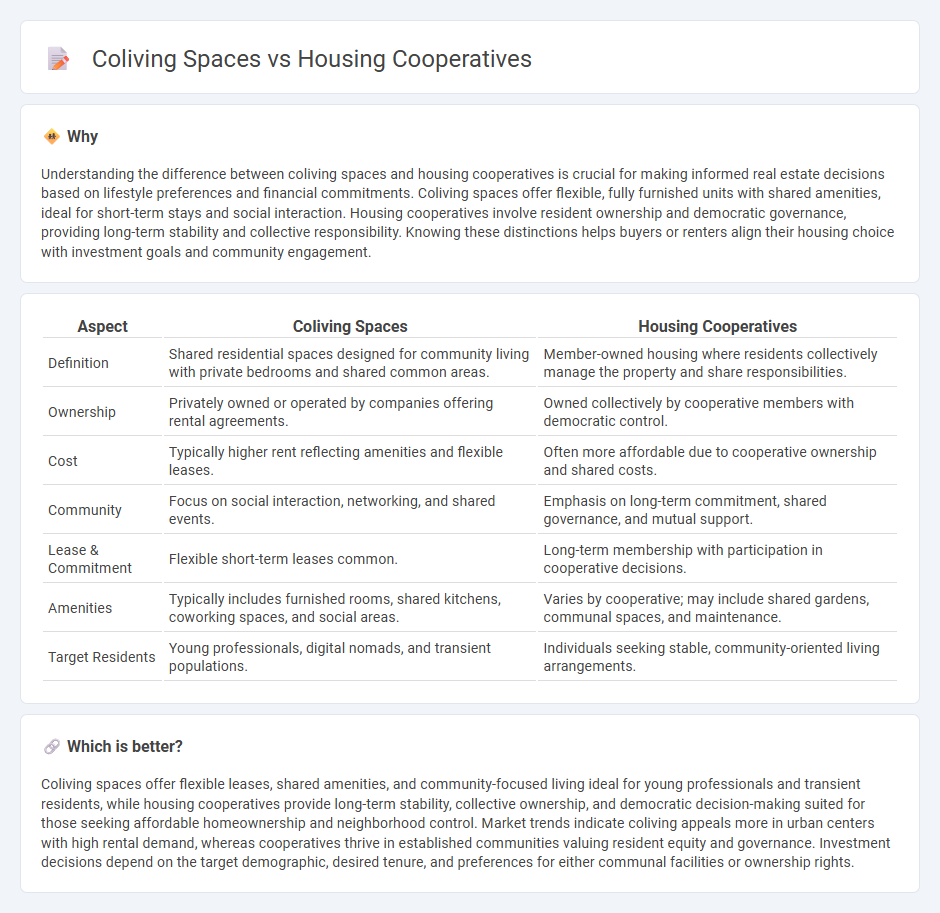
Coliving spaces offer flexible, community-focused living arrangements often favored by young professionals and digital nomads, providing furnished spaces and shared amenities for convenience and social interaction. Housing cooperatives, on the other hand, are collectively owned residential communities where members share responsibilities and decision-making, fostering long-term stability and affordability. Discover more about how these innovative housing models compare and which one suits your lifestyle best.
Why it is important
Understanding the difference between coliving spaces and housing cooperatives is crucial for making informed real estate decisions based on lifestyle preferences and financial commitments. Coliving spaces offer flexible, fully furnished units with shared amenities, ideal for short-term stays and social interaction. Housing cooperatives involve resident ownership and democratic governance, providing long-term stability and collective responsibility. Knowing these distinctions helps buyers or renters align their housing choice with investment goals and community engagement.
Comparison Table
| Aspect | Coliving Spaces | Housing Cooperatives |
|---|---|---|
| Definition | Shared residential spaces designed for community living with private bedrooms and shared common areas. | Member-owned housing where residents collectively manage the property and share responsibilities. |
| Ownership | Privately owned or operated by companies offering rental agreements. | Owned collectively by cooperative members with democratic control. |
| Cost | Typically higher rent reflecting amenities and flexible leases. | Often more affordable due to cooperative ownership and shared costs. |
| Community | Focus on social interaction, networking, and shared events. | Emphasis on long-term commitment, shared governance, and mutual support. |
| Lease & Commitment | Flexible short-term leases common. | Long-term membership with participation in cooperative decisions. |
| Amenities | Typically includes furnished rooms, shared kitchens, coworking spaces, and social areas. | Varies by cooperative; may include shared gardens, communal spaces, and maintenance. |
| Target Residents | Young professionals, digital nomads, and transient populations. | Individuals seeking stable, community-oriented living arrangements. |
Which is better?
Coliving spaces offer flexible leases, shared amenities, and community-focused living ideal for young professionals and transient residents, while housing cooperatives provide long-term stability, collective ownership, and democratic decision-making suited for those seeking affordable homeownership and neighborhood control. Market trends indicate coliving appeals more in urban centers with high rental demand, whereas cooperatives thrive in established communities valuing resident equity and governance. Investment decisions depend on the target demographic, desired tenure, and preferences for either communal facilities or ownership rights.
Connection
Coliving spaces and housing cooperatives both emphasize community-driven living, sharing resources and common areas to reduce costs and foster social interaction. Each model promotes affordability and sustainability by combining private living quarters with collective management structures that empower residents. Their connection lies in prioritizing collaborative ownership and cooperative decision-making to enhance housing accessibility and quality.
Key Terms
Ownership Structure
Housing cooperatives operate under a member-owned structure where residents hold equity and participate in decision-making, ensuring democratic governance and long-term affordability. Coliving spaces typically follow a rental model with centralized ownership or management companies maintaining control over property and operations. Explore deeper insights into ownership models and resident empowerment in communal living environments.
Community Governance
Housing cooperatives emphasize collective ownership and democratic decision-making, where residents actively participate in governance to ensure shared responsibilities and equitable resource management. Coliving spaces offer flexible, rental-based living arrangements with curated social environments but typically maintain centralized management with limited resident control. Explore the nuances of community governance models to determine which housing option best supports your lifestyle and values.
Lease Agreement
Housing cooperatives require members to sign a proprietary lease granting rights to occupy a specific unit while participating in shared ownership and governance of the entire property. Coliving spaces typically operate under standard lease agreements with flexible terms, offering furnished units and communal amenities without equity stake or management responsibilities. Explore the detailed differences in lease agreements to determine which housing option best suits your living and financial needs.
Source and External Links
Housing cooperative - Wikipedia - A housing cooperative is a legal entity owning residential buildings where members purchase shares granting them occupancy rights, allowing collective resource pooling and member control over residency decisions, distinguishing it from other housing forms like rentals or condominiums.
Housing Co-ops - Cooperatives for a Better World - Housing co-ops are resident-owned communities where each member has a share and a vote, collectively owning and managing the property to increase affordability and stability by operating on an at-cost basis without middlemen.
How to start a housing co-op - Shareable - Housing co-ops come in various types such as rental or leasehold co-ops, market rate co-ops, and affordable limited or zero-equity co-ops, offering residents democratic control, cost savings, and options for permanent affordable housing through nonprofit support and subsidies.
 dowidth.com
dowidth.com